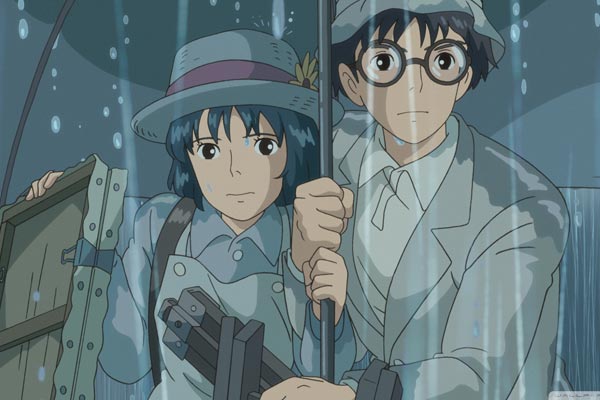Ask anyone about the first time they saw a Studio Ghibli film and you will inevitably hear the word ‘discovery’, usually followed closely by the words ‘wonder’ and ‘beautiful’.
Western audiences have been discovering the Japanese animation studio’s masterpieces in even greater numbers since the release of ‘Spirited Away’ in 2001. Zane Trow, Creative Arts Manager at Redland Performing Arts Centre, speaks about the third and final Studio Ghibli Film Festival being held at the Centre on 29 and 30 July.
Like many parents, Trow discovered Studio Ghibli by watching the movies with his children. At first glance, ‘My Neighbour Totoro’ seems to be the innocent story of two children discovering a magical forest creature in their new home. But, like all Ghibli films, there is depth and artistry which rewards repeated viewings, and, like all Ghibli films, encourages you to search for more. Fortunately, Ghibli’s catalogue is wide, and for the last three years, the Redland Performing Arts Centre (RPAC) have been working on bringing it the big screen. In this third and final year of the Festival, the three films shown will be ‘The Tale of Princess Kaguya’, ‘The Wind Rises’ and ‘Tales from Earthsea’.
 Image © Nibariki
Image © NibarikiWhen the festival began, audiences were made of regular supporters of RPAC who weren’t especially keen on animation, but attended anyway, just to support the Centre. This changed. Audiences had discovered Ghibli. In the second year, attendance grew and the festival became a draw-card for all audiences.
“Whether you like animation or not, whether you’re into Japanese culture or not, they are some of the best films ever made in any kind of genre, or any kind of film form. They are so beautiful,” Trow says. Ghibli’s films are indeed cinematic masterworks, emphasising a signature, hand-drawn style which subtly embraces light and dark, colour and tone, movement and stillness. Each frame is its own work of art, proudly bearing the traces of brush and pen, rather than perfectly rendered polygons.
Studio Ghibli is often referred to as “the Disney of the East”, doing it a great disservice. What continues to draw people to Ghibli’s films, turning audiences into fans, and fans into recruiters, is the vast and complex way in which its works differ from the Mouse House’s offerings. Apart from its distinct artistic style, two important differences set the Japanese films apart: families, and girls. Trow explains: “Disney’s formula relies on a very American-style version of family, and an American-style notion of what family entertainment is... [In Disney films] the family is everything, and it’s a nuclear family. And that’s the solution to the world’s problems, to have this fantastic mum and dad and the kids.”
 Image © Nibariki
Image © NibarikiFrom ‘The Lion King’ to ‘Frozen’, the major catalyst in many of Disney’s plots is the break-down of the nuclear family, with the ensuing character arc closely following the struggle to reassemble it. Instead of concerning themselves with repeating the same quest for suburban normality, Ghibli’s films are populated with different characters and different relationships. “You can see multiple ideas of how life can be lived,” Trow says. “Ghibli has beautiful stories that can be read and watched on so many different levels.”
For Ghibli’s most celebrated director, Hiyao Miyazaki, the director of the studio’s biggest pictures, these stories include themes rarely touched upon by Disney: environmentalism, and, for almost every picture, feminism. Which brings us to Ghibli’s girls. When the main protagonist of a Ghibli movie isn’t a young woman, there is certainly a plucky, intelligent, strong female co-lead right alongside. In film after film, women are the stars driving the action; they are taking charge, working hard and fighting at the front. It is difficult to think of an example where another character ever even calls into question their can-do attitude because they are ‘just a girl’. Ghibli films, Miyazaki’s in particular, show us worlds where women aren’t just equals, but the heroes. Find that in a Disney film. And don’t say ‘Mulan’ – remember, she had to dress up as a man to be taken seriously.
 Image © Hatake Jimusho
Image © Hatake JimushoThe Studio Ghibli Film Festival is not to be missed. For fans of all things Ghibli, it will be a rare opportunity to see these works on the big screen. Trow and RPAC have been working hard to produce the best quality possible for their audiences.
For everyone else, everyone who isn’t really into animation or kids films, once they decide to go along, they will be in the oddly wonderful position of being envied by people they don’t know. It’s not just animation, or Japan, or a kids film, it’s all three, and more. It’s Studio Ghibli. Everyone who has already seen a Studio Ghibli film remembers the wonder and beauty that audiences are about to discover.
Studio Ghibli Film Festival takes place at Redland Performing Arts Centre 29-30 July.
– written by Sam Franzway






